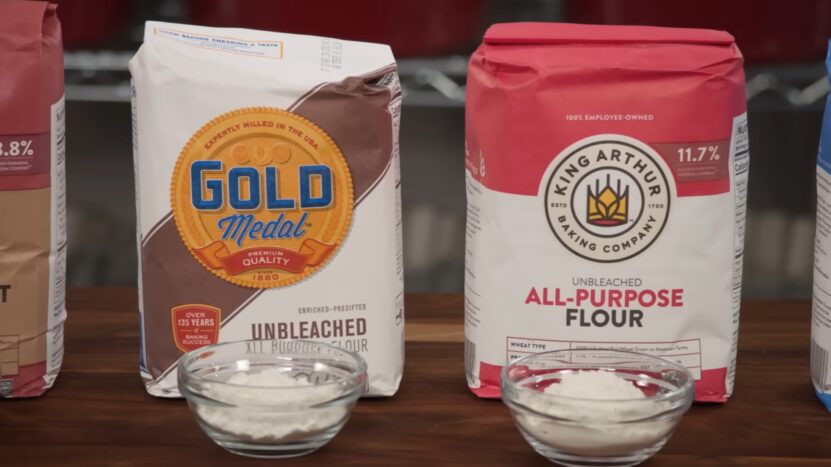In recent years, the safety of consuming raw flour has garnered significant attention. From homemade cookie dough cravings to the rising popularity of no-bake treats, the question of whether it’s safe to eat raw flour has become increasingly relevant.
Today, I will explain the risks associated with consuming raw flour, highlight important safety concerns, and provide practical advice for handling flour in your kitchen.
Key takeaways
- Consumption of Raw Flour is Risky: Raw flour can be contaminated with harmful bacteria like E. coli and Salmonella, posing significant health risks if consumed without proper cooking.
- Heat-Treatment as a Safe Alternative: Heat-treating flour at home (baking at 165°F for 5-10 minutes) can kill bacteria, making it safe for recipes that traditionally use raw flour.
- Safe Handling Practices are Crucial: Washing hands, tools, and surfaces after handling raw flour and storing flour properly are essential steps to prevent contamination and foodborne illness.
- Awareness and Education are Key: Understanding the risks associated with raw flour and being informed about safe handling and cooking practices can help in preventing foodborne illnesses.
- Baking Kills Bacteria: Cooking flour-based products to the right temperature is vital, as the high heat effectively kills any harmful bacteria present in the flour.
The Risks of Raw Flour
Flour, a seemingly harmless kitchen staple, harbors hidden dangers. The primary concern is the potential contamination with harmful bacteria such as Salmonella and E. coli.
These pathogens can thrive in the grain while it’s growing in the field or during processing and packaging.
A notable incident occurred in 2016 when an E. coli outbreak was traced back to raw flour, leading to widespread recalls. This incident underscores the risks involved in consuming flour without proper cooking.
Insights from Health Authorities
The Centers for Disease Control and Prevention (CDC) and the Food and Drug Administration (FDA) have both issued warnings about the consumption of raw flour.
The CDC explicitly lists raw flour as a food that can cause food poisoning, while the FDA strongly discourages eating it due to these safety concerns.
These advisories are based on research and incidents that demonstrate the real risks associated with raw flour.
Symptoms and Health Implications
Consumption of contaminated flour can lead to serious health issues. Symptoms of food poisoning from E. coli or Salmonella can include stomach cramps, diarrhea, vomiting, and fever.
In severe cases, these infections can lead to hospitalization or long-term health problems. Knowing these risks is crucial for anyone handling or consuming flour-based products.
Safe Handling and Consumption Practices

To minimize the risks of foodborne illness, the CDC recommends several safe handling practices for flour.
These include washing hands, tools, and countertops thoroughly after handling raw flour or dough.
Such practices are essential to prevent cross-contamination in the kitchen, protecting not only the individual handling the flour but also others who may come into contact with the contaminated surfaces.
Homemade Edible Cookie Dough: A Safe Alternative
For those who love the taste of raw dough, there is good news. Homemade edible cookie dough can be made safely by heat-treating the flour to kill any harmful bacteria and excluding raw eggs from the recipe.
This allows for the enjoyment of cookie dough without the associated risks.
However, it’s important to store edible cookie dough in an airtight container and keep it chilled or frozen if it’s to be kept for an extended period.
The Importance of Baking
Baking is an effective method to eliminate harmful organisms in raw dough. The high temperatures achieved during the baking process kill bacteria, making the final product safe to consume.
This underscores the importance of following recipes and cooking instructions, especially when preparing treats that include flour.
Impact of Flour Contamination
Flour contamination has led to recalls and public health concerns. The 2016 E. coli outbreak is a prime example of how quickly contamination can spread and impact a large number of people.
These incidents highlight the need for strict quality control measures in the production and packaging of flour, as well as public education about the risks of consuming raw flour.
Long-Term Health Implications
While most people recover from food poisoning without long-term effects, some may suffer from more severe consequences.
Kidney failure, chronic arthritis, and other serious health issues can result from bacterial infections like E. coli.
This makes the issue of consuming raw flour not just a matter of temporary discomfort but a potential long-term health risk.
Educational Efforts and Awareness
Educating the public about the dangers of eating raw foods such as potatoes or flour and the proper handling techniques is crucial.
Awareness campaigns, clear labeling on flour packaging, and educational resources can play a significant role in reducing the incidence of flour-related foodborne illnesses.
Alternatives You Can Go For

The process of heat-treating flour involves heating it to a temperature that kills potentially harmful bacteria.
This method has gained popularity as a safe alternative for recipes that traditionally use raw flour.
You can easily heat-treat flour at home by spreading it on a baking sheet and baking it at a specific temperature for a set duration.
This makes it a viable option for those who enjoy raw cookie dough or other similar treats without the associated health risks.
Gluten-Free and Alternative Flours
For individuals with gluten sensitivities or those seeking a different nutritional profile, alternative flours like almond, coconut, or oat variations can be considered.
These not only provide a gluten-free option but also come with their own set of nutritional benefits.
However, it’s important to note that while these flours don’t contain gluten, they may still need to be heat-treated if they are to be consumed raw, as they can also harbor harmful bacteria.
The Role of Flour in Nutrition
Flour, whether it’s traditional wheat or an alternative variety, plays a significant role in nutrition.
Whole grain variation, in particular, is a good source of fiber, vitamins, and minerals.
Knowing the nutritional content of different types of flour can help in making informed choices about which flour to use for various culinary needs.
Practical Tips for Handling Flour Safely
Storage and Shelf Life
Proper storage of flour can help maintain its quality and reduce the risk of contamination. It should be kept in a cool, dry place, preferably in an airtight container, to prevent exposure to pests and moisture.
Additionally, being mindful of the shelf life and using flour within its best-before date ensures that it’s consumed when it’s at its best quality.
Cleanliness in the Kitchen
Maintaining cleanliness in the kitchen is paramount when handling flour.
This includes washing hands thoroughly before and after handling flour, using clean utensils and surfaces, and avoiding cross-contamination with other foods.
These practices are essential in preventing the spread of bacteria and ensuring a safe cooking environment.
Educating Home Bakers
Educating home bakers and cooks about the risks associated with raw flour and the importance of proper handling and cooking is crucial.
This can be achieved through cooking classes, online resources, and clear instructions on flour packaging. Empowering individuals with this knowledge helps in making safer food choices at home.
FAQs
Can I make my heat-treated flour at home?
Yes, you can make it at home by spreading flour on a baking sheet and baking it in the oven at 165°F (74°C) for about 5 to 10 minutes.
Are organic flours safer to eat raw compared to conventional ones?
No, organic variations are not necessarily safer to eat raw. They are also susceptible to bacterial contamination, just like conventional flours.
Can consuming raw flour affect individuals with a compromised immune system more severely?
Yes, individuals with compromised immune systems are at a higher risk of developing more severe complications from consuming contaminated raw flour.
Is it safe to taste a small amount of raw dough or batter while cooking?
It’s not recommended to taste raw dough or batter that contains raw flour, as even a small amount can contain harmful bacteria.
Can freezing raw dough kill harmful bacteria in flour?
Freezing does not kill bacteria in flour. Cooking to the right temperature is necessary to eliminate harmful bacteria.
Are there any visual signs that flour might be contaminated?
No, contaminated flour usually does not have any visual signs. The presence of harmful bacteria can only be determined through testing.
Final Words
The consumption of raw flour poses significant health risks due to the potential presence of harmful bacteria. Health authorities like the CDC and FDA have issued warnings against eating raw flour, citing the dangers of food poisoning.
To minimize these risks, it is essential to practice safe handling, opt for safe alternatives like heat-treated flour in recipes, and understand the importance of cooking flour-based products thoroughly.
